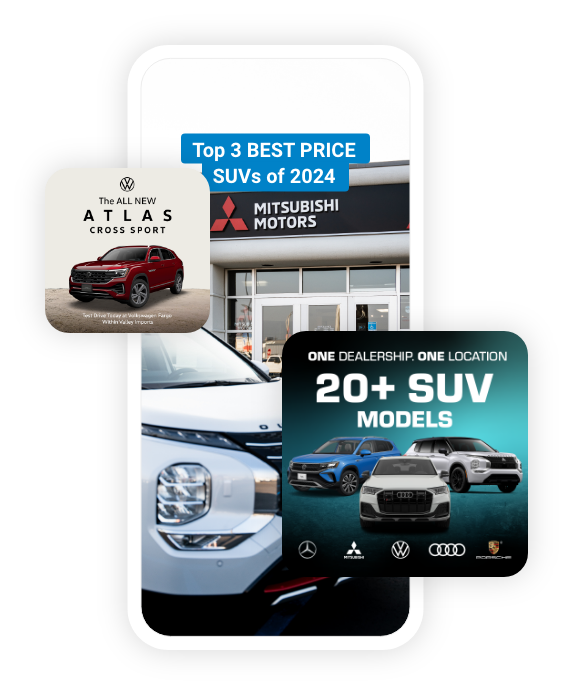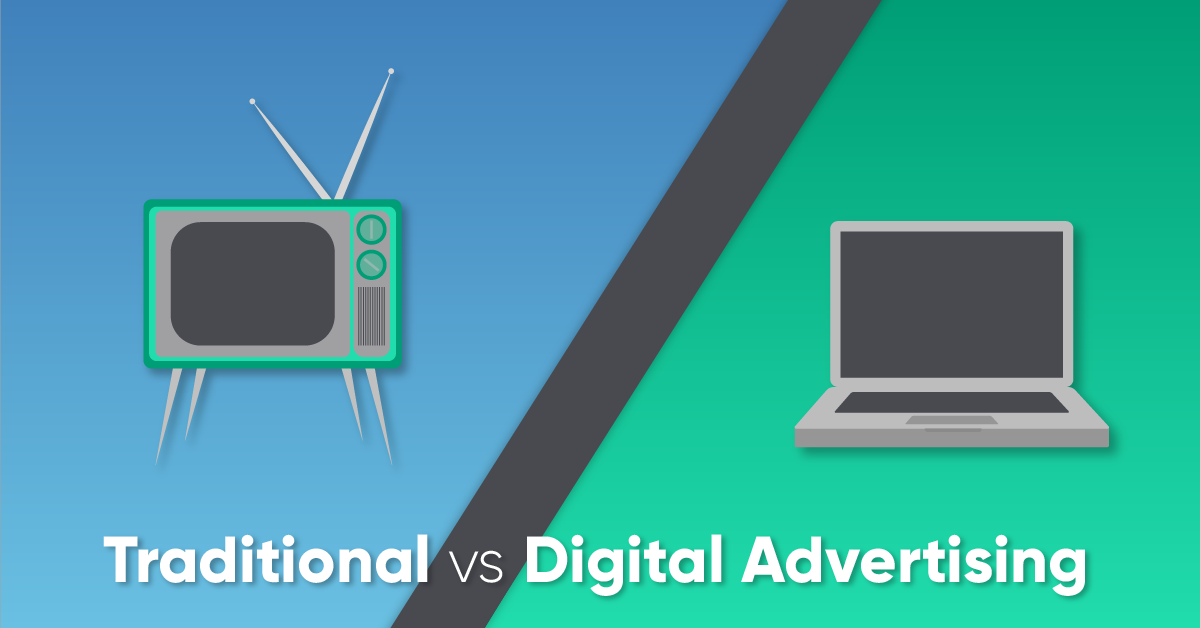Traditional VS Digital Advertising: What’s Best for Your Business?
Before we dive into the deep sea of traditional vs digital advertising methods, let’s make something clear. Yes, we’re a digital marketing company and inherently have a bias towards digital marketing. The goal of this article isn’t to promote ourselves or digital marketing. The goal of this post is to educate and give important insights into the world of advertising. We’re making every effort to forget the sales pitch and state the facts.
Did we achieve this? Tough to say, you be the judge.
Can Traditional Advertising Work Today?
Short answer. Yes, absolutely. Most forms of advertising, done correctly can make an impact.
Traditional isn’t dead by any means. Many business owners and executives prefer traditional because it’s what they know. However, these same companies often fail at adapting to the changing times. They end up over-allocating to one channel or completely forget about another.
Determining the Right Balance
There’s no definitive rule for finding the perfect balance between traditional and digital. But it usually comes down to the type of business or product you are trying to advertise. Keeping an equal balance between your traditional and digital ad budgets may work for some businesses. But keeping an eye on the performance of each campaign can usually point you in the right direction.
Traditional platforms are easier for business owners to understand. So naturally many small businesses continue doing the same things they have been doing for years, which is never a good idea.
“It’s just the way things have always been done”
The Digital Age & Battle For Attention
There has been a major cultural shift in recent years. Society has adopted a “media-on-demand” mentality and attention spans are lower than ever. Overall we are consuming less traditional media in favor of an easier to consume digital media from the palm of our hand.

There’s a lot more noise. Consumers have become accustomed to fast-paced content and getting what they want when they want it, and how they want it.The internet has revolutionized the way we communicate, find information, and do business. New digital platforms have emerged that offer the same basic services as traditional media, but with an on-demand and deeply personalized experience.
Today’s consumers are divided across dozens of traditional and digital platforms, making it harder than ever to reach them.
Challenges with Digital
Again, the goal of this post is to educate you on some of the issues that plague modern advertising. Let’s take a quick look at some of the most common problems facing digital advertising.
The Rise of Ad Blockers
An ad blocker is a piece of software designed to prevent certain advertisements from appearing on a web page.
Let’s face it, most people hate ads. Of any kind. Digital advertising has given us the ability to directly track results, but consumers have also gained the ability to block certain ads through ad blockers. At first glance, ad blockers may seem like a major roadblock for digital advertisers but only around 18% of internet users have some form of ad blocker.
What ads do they block? Most ad blockers only block banner ads or annoying pop-ups. Really anything that interrupts the user’s experience. This rarely affects well-executed digital campaigns. Search engines and social media make up the bulk of effective digital campaigns and for the most part, those ads are unaffected by ad blockers.
Limitations of Search Ads
Search advertising can be a great way to advertise your business or product. You get right in front of users as they are looking to buy. However, there are some challenges we face with search advertisements:
- The consumer needs to know in advance that your product or service exists. Revolutionary new products or ideas that haven’t been seen before can be difficult to market via search engines.
- Consumers tend to search broadly or use simple keywords. If you have a very niche business the user might not know how they should type in the search bar to find your specific business. There are many tactics and strategies to counter this, but getting things right takes time.
- Search advertising isn’t great for creating initial brand awareness. The same is true when consumer education is necessary. Although, there is a digital solution for brand awareness. And that solution is social media.
Future Problems For Social Media
Social media is great for getting initial brand awareness and educating the consumer on a product. But it’s not the only reason digital marketers love social media. Facebook, LinkedIn and Twitter combined have 3 billion active users. With advanced targeting options for user demographic and behavioral data, you can put together effective campaigns that rival search advertising. But much like search advertising, we face some challenges.
- The target demographic must use social media. This typically isn’t an issue as almost 81% of the US population and 33% of the world population uses social media. However, certain industries such as Agriculture or anything with an older demographic may have trouble with social media.
- Changes will be coming soon. Advertisers on Facebook will be losing some of the targeting options that were previously available. With the fallout from the Cambridge Analytica debacle and Zuckerberg testifying before congress, Facebook is playing it safe (at least for now). They have decided to remove some targeting options created through Facebook buying other data from other companies.
The jury is still out on how sweeping these changes will be but we know things will be a little different for Facebook advertising in the future.
The State of Traditional Media
Television
Most adults 65 and older watch almost 50 hours of traditional TV a week, but millennials and Gen Z only average around 11 hours per week. And that’s coming from the millennials and Gen Zers that actually watch traditional TV. Many younger Americans consider themselves “cord nevers.” Cord Nevers are people who have never had cable and never will. They rely on Netflix, Hulu, Amazon Prime, Youtube, Facebook, Twitter, and other video streaming to get their content.

What does this mean for advertisers?
DVR, premium cable, and streaming services have vastly impacted the effective reach of standard cable and TV. DVRs mean fast-forwarding through commercials while Netflix means commercial-free viewing. Studies have shown that 81% of U.S. households have either a DVR, Netflix, or some other on-demand programming. To avoid the “dreaded DVR fast forward,” advertisers have opted for live television broadcasts that people rarely record. Although this solves the problem, you may see an increased cost when looking to advertise on live TV.
Although “cord nevers” rely on the internet, they are still watching some form of TV one way or another.

Radio
Terrestrial Radio has been shrinking in reach and audience for many years. Satellite Radio giant SiriusXM became popular by becoming factory standard in newer vehicles.
Additionally, internet streaming services (like Pandora and Spotify) and the ease of taking music or audio with you via mobile phones (Podcasts, iTunes) have further diluted reach among traditional radio. These recent innovations mean fewer people are listening to local radio and the advertisements that you pay so much for are being heard by fewer and fewer people.
What does this mean for advertisers?
Be smart about where you’re allocating your ad dollars. It’s wise to spread it around but don’t focus solely on these mediums. Being creative and using different forms of media will help you stand out from the crowd and give you better results in the end.
Satellite and streaming have divided the radio market more than ever. But at the end of the day, it’s still radio.
Traditional “print media companies” have taken steps toward becoming digital. Most magazines and newspapers offer a digital version and many of those publications have become free via digital. They do this by selling digital banner ads. A drop in physical paper sales and a growing trend of people flocking to social media for the latest news has accelerated this process.
Google has replaced the phone book altogether as a way to gather information on local businesses. Sadly, phone books might be relegated to the museum sooner than later.
Physical papers may not be selling, but the idea is still the same. There is opportunity everywhere traditional has turned to digital. The trick is knowing how to capitalize on this shift.
What does this mean for advertisers?
This rise of digital media has largely taken over and vastly limited the overall reach of print mediums. It’s important to have clear goals in mind when considering print advertisements. Print can be less effective for directly driving sales, and your main goal in those cases should be brand awareness. If at all possible you should always try and find a publication with a very specific topic geared toward your target market (Runner’s World, Better Home and Gardens.)
Traditional Media Adapts
Although traditional companies are quickly moving toward digital mediums, you should take a step back before making quick decisions about who to trust with your digital advertising. Digital agencies and traditional media companies that offer digital have two totally different business models. It is important to know the difference.
Traditional media and phonebook companies like Dex and Yellowpages have seen significant declines in their reach and declining revenue from advertisers as companies are shifting budgets to sexier digital options.
Many of these companies are attempting to figure out the digital advertising landscape and work it into their offering, often combining their traditional options with new digital ads. This is great, however, these companies are rarely experts in marketing strategies and this can mean that performance or ROI become afterthoughts. Many of these companies even hire 3rd party companies to manage digital campaigns for them. This is obviously not ideal and just creates another layer of separation and accountability.
These large “old media” businesses tend to view digital advertising as another new revenue source for them, while performance marketing agencies view it as the best solution for generating results for their clients.
Digital marketing is an art form and doing it well requires extensive planning, knowledge, attention to detail, a results mindset, and years of experience to master. Specialized companies tend to have much more experience in providing real results and have the data to back it up.
Conclusion
- Educate yourself as much as you can
- Talk to other business owners
- Analyze and vet your options and choose what’s best for YOU
How Can AdShark Marketing Help?
Thought about adding digital marketing, Facebook ads or Google ads to your marketing plan, but unsure how to start? Reach out and we can help customize a strategy based on your needs and budget.
Ready To Grow?
Let's Talk!



